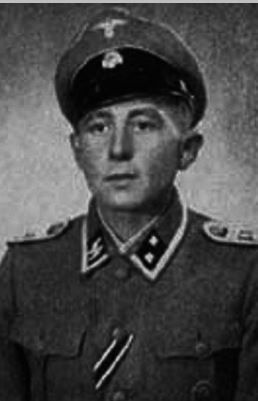Rieth, Herbert Albert (Waffen SS)
- Date of birth:
- February 11th, 1920 (Ottenheim Amtsbezirk Lahr/Republic of Baden, Germany)
- Date of death:
- April 29th, 1945 (near Halbe/Province of Brandenburg/Free State of Prussia, Germany)
- Buried on:
- German War Cemetery Halbe
Plot: 1. Row: 6. Grave: 238. - Service number:
- SS-Nr.: 490.026 // NSDAP-Nr.:
- Nationality:
- German (1933-1945, Third Reich)
Biography
Do you have more information about this person? Inform us!
- Period:
- Second World War (1939-1945)
- Awarded on:
- November 22nd, 1941
- Period:
- Second World War (1939-1945)
- Awarded on:
- January 30th, 1943
- Period:
- Second World War (1939-1945)
- Awarded on:
- August 12th, 1944
- Period:
- Second World War (1939-1945)
- Awarded on:
- August 30th, 1944
- Period:
- Second World War (1939-1945)
- Rank:
- SS-Untersturmführer der Reserve (2nd Lieutenant of Reserves)
- Unit:
- Führer, 5. Batterie, SS-Artillerie-Regiment 54, 23. SS-Freiwilligen-Panzergrenadier-Division "Nederland" (niederl. Nr. 1)
- Awarded on:
- December 11th, 1944
“SS-Untersturmführer Rieth has served as a Batterie commander in the II./SS-Art.Rgt. 54 since the 27.07.1944. Starting on the 17.10.1944 he occupied an observation post on the hill near Ozoli (14 km south of Preekuln).
Following a prolonged drumfire on the 29.10.1944, enemy infantry launched a major operation to seize this militarily important hill with attacks from the north, east and south. At the time Rieth was positioned in his observation post on the northern edge of the hill. In spite of the enemy attack, Rieth held his ground with grim determination while continuing his role as the fire-director for the whole Abteilung. The weakly held infantry strongpoints beside and behind his observation post were overrun. During this breakthrough Rieth offered determine resistance while under fire. By his efforts the enemy was brought to a halt while still on the hill as they attempted to advance westwards. As a result of his flexibly directed blocking fire, Rieth prevented the enemy from rolling up the friendly trenches to the north.
After Rieth and the men had gone over to close-combat fighting, Rieth began assembling individual straggling Grenadiers, created a blocking line along the north flank and managed to restore contact with the German frontline to the east. With his directed artillery fire he furthermore prevented the regrouping and reorganization of enemy forces on the hill. Rieth repeatedly led the handful of men under his command in new counterthrusts until his strongpoint was firmly secure.
His energetic intervention did not only prevent the enemy from continuing their attack to the west. More than anything he also stopped the expansion of the enemy penetration to the north as well as an envelopment of the threatened open flank here, which would in turn have led to a union with additional broken-in enemy forces 1 km north of this penetration.
After the assembly of friendly forces, a new counterattack was launched out of the strongpoint ‘Rieth’. With well-directed artillery fire in support, it succeeded in reconquering another portion of the hill. The recapturing of this sector was of decisive importance for the later counterthrust that repaired the hole in the frontline.
Through his ruthless military conduct, exemplary steadfastness and independently conducted handling of the battle, Rieth holds a decisive share in bringing this crisis to an end. In doing so he prevented a disintegration of this critical section of frontline. For his outstanding performance and successfully conducted defense here (achieved with only a small group), I believe Rieth to be worthy of the award of the Knight’s Cross to the Iron Cross.”
Sources
- Photo 1:
- - FELLGIEBEL, W.P., Elite of theThird Reich, Helion & Company Limited, Solihull, 2003.
- Microfilm Publication A3343. US National Archives. - Herbert Rieth | Gräbersuche-Online
- W-SS Honor Roll Clasp Recipients - Axis History Forum







